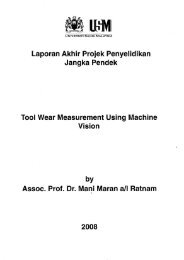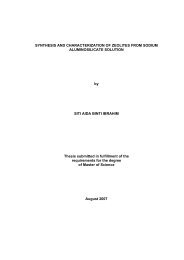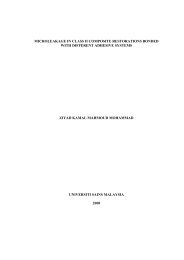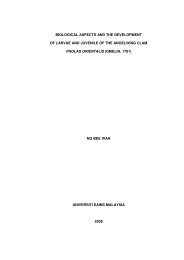a study on the performance of limestone roughing filter - ePrints@USM
a study on the performance of limestone roughing filter - ePrints@USM
a study on the performance of limestone roughing filter - ePrints@USM
Create successful ePaper yourself
Turn your PDF publications into a flip-book with our unique Google optimized e-Paper software.
2.7 Roughing Filter for Wastewater Reuse<br />
The wastewater produced from Mexico City was transported to <strong>the</strong> valley <strong>of</strong><br />
Mezquital, where it was used, to irrigate approximately 90,000 ha <strong>of</strong> agricultural lands.<br />
Even though <strong>the</strong> reuse <strong>of</strong> wastewater had increased <strong>the</strong> productivity <strong>of</strong> maize, oaths,<br />
alfalfa, sorghum and wheat between 71% and 150%, <strong>on</strong> <strong>the</strong> o<strong>the</strong>r side a corresp<strong>on</strong>ding<br />
increased in gastro-intestinal illness by helmin<strong>the</strong>s infecti<strong>on</strong>, had been reported.<br />
Children from 0-4 years <strong>of</strong> age had been shown to suffer up to 16 times <strong>the</strong> normal rate<br />
<strong>of</strong> such infecti<strong>on</strong>. Therefore, to protect <strong>the</strong> health <strong>of</strong> agricultural workers, and <strong>the</strong>ir<br />
families <strong>the</strong> WHO has adopted <strong>the</strong> regulati<strong>on</strong> that all types <strong>of</strong> agricultural irrigati<strong>on</strong><br />
water should c<strong>on</strong>tain less than 1000 fecal coliforms (MPN)/100ml (Jimenez et al.,<br />
2000). To meet that requirement, Mexican Nati<strong>on</strong>al Water Commissi<strong>on</strong> opted to use<br />
primary treatment by filtrati<strong>on</strong>. In <strong>the</strong>ir research, <strong>the</strong> model <strong>of</strong> <strong>roughing</strong> <strong>filter</strong> was used.<br />
According to results presented, <strong>the</strong> <strong>roughing</strong> filtrati<strong>on</strong> system was able to c<strong>on</strong>sistently<br />
produce effluents with fecal coliform less than 1000 (MPN)/100ml with 68% removal<br />
(Jimenez et al., 2000).<br />
Applicati<strong>on</strong> <strong>of</strong> treated wastewater for irrigati<strong>on</strong> has become a comm<strong>on</strong> practice<br />
worldwide and a centre <strong>of</strong> attenti<strong>on</strong> to scientists and technologists in developing<br />
countries (Hamoda et al., 2004; Lubello et al., 2004). One <strong>of</strong> <strong>the</strong> treatment techniques<br />
which have been intensely scrutinized is <strong>the</strong> wastewater stabilizati<strong>on</strong> p<strong>on</strong>d systems.<br />
However that technique has been found costly to c<strong>on</strong>struct and expensive to operate<br />
and maintain. Roughing filtrati<strong>on</strong> was <strong>the</strong> opti<strong>on</strong> for low cost and appropriate<br />
technology to treat wastewater. Combinati<strong>on</strong> <strong>of</strong> <strong>roughing</strong> <strong>filter</strong> and c<strong>on</strong>structed wetland<br />
could remove total suspended solid <strong>of</strong> 89.35%, BOD 5 <strong>of</strong> 84.47% and fecal coliform <strong>of</strong><br />
99.99 % (Kimwaga et al., 2004).<br />
12

















